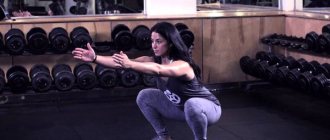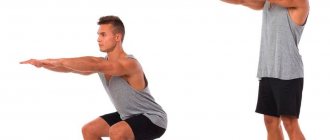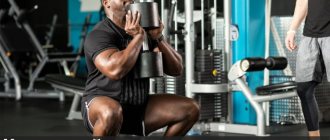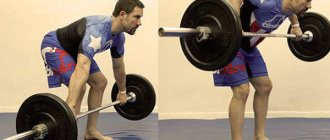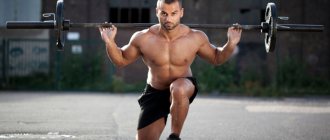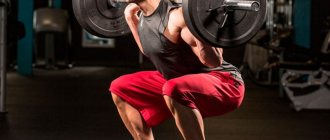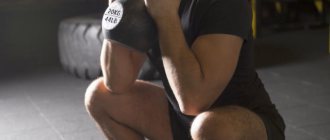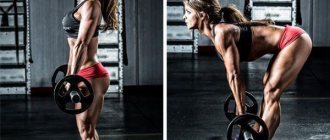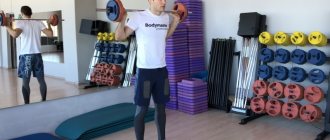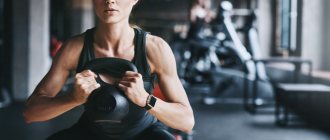Squats with weights on the chest, called front squats, are rarely done by modern athletes. Many people have heard about this method of performing a well-known basic movement, but due to ignorance of the technique, it is rarely included in the training program. Meanwhile, the front squat gained popularity even before the era of bodybuilding: it was practiced by athletes while preparing for a power push of a barbell.
- What muscles are used during front squats?
- Benefits of Front Squats
- Technique for performing front squats with a barbell on the shoulders
- Features of the front grip during a front squat
- Step-by-step front squat technique
- Video: how to properly squat with a barbell on the front
- Smith machine front squat
- Video: Smith machine front squat technique
- Front squats with dumbbells and kettlebells
- Video: chest squat technique
- Recommendations for performing front squats
What kind of squats are these?
Everyone knows what a barbell squat is: throw the weight on your shoulders and go squat. This is the base. It allows you to pump your entire body. The legs work predominantly (the main emphasis is on the quadriceps; the gluteus maximus and hamstrings are also loaded), and the remaining muscles are involved in stabilizing the body position at each moment of the exercise.
Front squats in this regard can also be called a base, but more specific. Today it is considered to be an additional exercise in bodybuilding. And this is the correct opinion:
- Front squats can and should be performed in a deep version (that is, when the hips at the lowest point rest on the calves). In this case, the buttocks are used as much as possible.
- Less strain on your back as you keep it straight.
- There is always more weight in basic exercises than in additional exercises. A front squat allows you to lift less weight than a back squat (considered to be 85% of your base weight).
Therefore, front squats should be performed as an addition to the basic version.
Interesting Facts
This exercise is mainly used by weightlifters. The push of the barbell requires a squat when jerking it to the chest, since without it such large weights simply cannot be conquered.
The phase in which, after squatting, the athlete rises to a straight position for the subsequent push, is an analogue of the front squat. And so that there are no problems with it, these squats are worked out as a separate exercise.
And this is far from the only example of a movement that representatives of other strength sports can borrow from weightlifters.
It is worth noting that tall people find it easier to do front squats than classic ones.
How can you squat
It all depends on your body and the availability of the gym:
- with a barbell;
- in Smith;
- with dumbbells or kettlebells.
If you work out at home, dumbbells are suitable for you. For girls, the weight of a dumbbell of 12 kg (each) is enough to pump up beautiful buttocks and thighs. That's just how they are, these girls. But a man needs loads many times greater. You won’t achieve noticeable results at home without a barbell.
In Smith, those who cannot maintain balance with a free barbell squat. These are beginners or people with any injuries or physiological characteristics.
The front squat is the heaviest option listed.
Benefits of Exercise
A distinctive feature of this type of squats is the location of the bar, which is unusual for many athletes. Unlike the more standard version, the barbell is placed on the chest and deltoids, and not on the back muscles at all.
This variation results in the back being in an almost vertical position, which radically changes the load on the body. And the muscles that are involved in the work change radically.
What muscles work:
- The main work is done by muscle units such as quadriceps.
- The auxiliary muscles are the gluteus maximus, gastrocnemius, soleus, posterior thigh muscles, as well as the rectus and oblique abdominal muscles.
Thus, there are a huge number of advantages in using this type of squats:
- An undeniable help in building well-developed thighs, a strong lower back and strong abs.
- Reducing the compressive effect on the spinal column, and therefore on the entire back, minimizing knee injury.
- Lack of lumbar torque.
- There is a high probability of performing the exercise with the correct technique. Otherwise, the barbell will immediately fall to the floor and you won’t be able to squat. And mastering the correct technique is crucial in any athlete’s training cycle.
- Formation of impressive core muscles, development of more reliable stability.
- If a plateau occurs when training your legs, it easily eliminates this problem, literally exploding muscle growth.
- Promoting better fat burning.
What you need to know before you start squatting
Before any squats you will need to pay attention to a few points:
- your stretch;
- shoes;
- cloth;
- health of the back and leg joints.
Front squats require a good stretch. Therefore, pay attention to stretching your legs and lower back. Without it, it will be difficult for you to maintain correct posture during exercise.
As for shoes, there is a special type for athletes - weightlifting shoes. They have a small tight heel. We recommend purchasing these shoes to make front squats more effective and less dangerous.
When you squat with a barbell, try not to wear clothing that absorbs moisture. It is better for the fabric to wick moisture out.
If you have lower back pain, you should not squat temporarily. Relieve pain, strengthen your back and lower back muscles using the techniques that we described in a special article. Then start a front squat without any weight - with an empty bar.
An empty bar is your friend until you have perfect technique. Don’t listen to trainers who shout: “Wear normal weight, the technique will form itself!” No, it won't form. A hernia of the spine can form on its own, but you need to carefully work on the technique.
If you notice pain in your knees, try wrapping them with an elastic bandage during the exercise. So now we're ready to start the front squat.
Tips for implementation
To get good results from the exercise, focus on working the muscles, namely your glutes and thighs. The number of approaches and repetitions, although important, is still in second place.
Sets and reps
In order to get slender legs and firm buttocks, you need to build up some muscle. Yes Yes exactly. But don't be afraid to overpump, because this is unlikely to happen.
To achieve muscle growth, you need to work in the range of approximately 8-12 repetitions at a moderate pace (so that the exercise lasts 30-40 seconds).
The same interval is good for losing weight, but coupled with proper nutrition.
The number of working approaches should not be more than 2-3, warm-up approaches can be 1 or 2. Moreover, if you do 2 warm-up approaches, do the first with a very light weight, and in the second the weight should be slightly increased.
Weight of barbell and dumbbells
The weight needs to be selected so that you can perform 12-15 repetitions with it in perfect technique and not get tired. Once you determine the weight, you can increase it from workout to workout. As a result, you need to come up with a weight with which you can perform 12 repetitions, but with great difficulty.
Technique
There are 2 options for setting your feet: wide and close, we recommend staying at shoulder width. Don't forget to stretch your legs well and warm up your joints.
It is very important to have a mirror in front of you. You must see yourself, then you will notice all your mistakes. A mirror on the side is a bad option. You will have to turn your head. When you are doing front squats, you cannot be distracted. The technique itself is quite complex, so study it carefully before starting the exercise.
- We place the barbell so that when removing it we do not have to stand on our toes. The ideal option would be one in which you squat slightly to remove it.
- Typically, barbell racks are located in a power frame. We recommend setting the safety bars at a level just above your lowest point during a deep squat. If you squat in splendid isolation, such insurance will help you out.
- Therefore, we hang the barbell inside the frame. It doesn’t matter how you stand inside the frame. Just keep in mind that after removing the barbell, it is more convenient to take a step forward rather than back to begin the exercise.
- Stand next to the barbell with the bar facing forward. Move closer to it so that it rests on your shoulders in the area where the deltoids meet the trapezius muscle.
- Bend your elbows and with your palms facing up, fix the bar at this point. We try to lift our elbows up.
- Please note that your hands are shoulder-width apart. We lift the bar with our torso and take a small step away from the racks. If the bar holds steady on you, everything is fine. If not, experiment. Some people cross their arms, others hold themselves exactly as we suggested. Everyone takes it in the way that is most convenient for him. The main thing is that the bar does not roll down and put pressure on the joints.
- Don’t forget about posture: pelvis back, back straight. There is no need to tilt your head down and lift it up. Let's look straight. The head is an extension of your back. And we keep our backs straight. The front squat always requires correct posture.
- We straightened out and began to go down. We always make sure that the pelvis is pulled back - this is the main condition for the absence of lower back injuries. We descend smoothly and slowly (1.5-2 seconds) to the very bottom. If you have set up a belay, make sure that the bar does not hit it.
- As you exhale, rise from the lowest point. We push our heels off the floor, the movement is fast and strong. Your task is to go down slower and go up faster. Inhale - we lower ourselves, exhale - we return to the starting position.
- We repeat the exercise the required number of times. Correct technique – maximum results.
Training programs
Please note that in the description of the schemes, the notation is used, where the number of approaches is first indicated, and then the number of repetitions in these approaches. For example, writing “2 x 5” means 2 sets of 5 reps, not 5 sets of 2 reps. With this system, the athlete will be able to take more and more weight with each successful “wave”, as the nervous system will gradually adapt to the loads
This method is designed for the most advanced athletes who want to develop maximum muscle strength. For example, an athlete can squat 2 times with 150 kg on the first wave, 2 times with 160 kg on the second wave and 2 times with 170 kg on the third wave
With this system, the athlete will be able to take more and more weight with each successful “wave”, as the nervous system will gradually adapt to the load. This method is designed for the most advanced athletes who want to develop maximum muscle strength. For example, an athlete can squat 2 times with 150 kg on the first wave, 2 times with 160 kg on the second wave, and 2 times with 170 kg on the third wave.
- 1 x 5, 1 x 3, 1 x 2
- 1 x 5, 1 x 3, 1 x 2
- 1 x 5, 1 x 3, 1 x 2
Another variation of this system is 12 approaches in 4 waves. It also does fewer reps per set than the previous version of this method:
- 1 x 3, 1 x 2, 1 x 1
- 1 x 3, 1 x 2, 1 x 1
- 1 x 3, 1 x 2, 1 x 1
- 1 x 3, 1 x 2, 1 x 1
In this system, you start with a weight that you can easily do 6 sets of only 2 reps. And, depending on the individual characteristics of the body, this weight will be about 80 - 87% of your maximum. Since the goal of these workouts is to increase muscle strength, after a while you will be able to do 6 such approaches for 4 repetitions.
This method is effective because the load increases gradually. The athlete increases the number of repetitions only when he is able to fully perform the exercise with the previous weight. This system works on the principle of repeated repetitions, which means that over time the nervous system gets used to new loads, which gradually become the norm.
After the 5 x 2 workout, the load is reduced by 7 percent, and the next stage is 5 sets of 3 repetitions.
In this method, you need to perform 8 single approaches, and then 5 x 3-5. In the Hepburn method, the first 8 sets are performed in a normal stance, and the next 5 x 3-5 in a rack with heels raised to a height of 2-2.5 cm.
Mistakes and how to avoid them
Posture is the basis of proper technique
When you do front squats, you need to maintain correct posture - your chest sticks out a little forward, your pelvis moves back, your lower back bends forward. Practice has shown that every second beginner makes many mistakes related to these nuances.
The most common type of violation when doing front squats is rounding of the lower back. When you get up from the bottom point (and we agreed that front squats will be deep), the lower back bends in the other direction, and the pelvis begins to “walk.” This instability will lead to injury.
How to fix: lose weight. We do the exercise with an empty bar in front until the technique becomes correct. Then slowly increase the weight. If you strive for the scales, but forget about technique, the result will be sad.
We place our feet incorrectly
Observe the beginners, how they place their feet, where their toes point. It happens that they squat with their knees inward. Front squats, like all others, do not allow this to happen.
How to fix: point your toes so that they point towards your knees. And turn your knees slightly to the side. Toes should turn out to the sides by 15-30 degrees. But, under no circumstances should they be reduced to each other - this greatly increases the load on the knee joint.
We don't do the exercise because we can't hold the barbell.
Sometimes it happens. A person takes a bar weighing 20 kg, places it on his shoulders, but the bar rolls down to his elbows. They tell him to raise his elbows, but he can't. What to do:
- Your shoulders are not flexible enough. Your personality plays a big role. It can be partially corrected by working with the flexibility of the shoulder girdle.
- If your shoulders are not strong enough to lift your elbows high, you need to pump yourself up.
- You place the bar incorrectly - the most common reason for it sliding towards the elbows.
You can solve the problem even easier - take dumbbells and do front squats with them.
What muscles does the exercise work?
Since the exercise technique is not easy, many athletes ignore this front squat. However, it is one of the basic ones, which perfectly works many muscle groups. First of all, the quadriceps are involved, secondly the buttocks, calf muscles, and hamstrings work. At the same moment, the following muscles work in the opposite direction: gluteus maximus, adductor and soleus muscles. The stabilizing function is performed by the hamstrings and calf muscles. The abdominal muscles are also involved.
With proper exercises you can achieve the following results:
- Work your hips and develop powerful quads.
- Strengthen your lower back and abdominal muscles.
- Remove excess stress from your back and reduce the likelihood of injury to your knee joints.
- Protect your back muscles by keeping your body vertical.
- Reduce lumbar load.
- Develop balance and build core muscles.
- Exercise has a good fat burning effect.
As can be seen from the description, this type of squats allows you to achieve good effects in working out the muscles and at the same time is less traumatic for the body if performed correctly.
Front Squats
Training scheme
If you use the exercise as your main one, we recommend doing at least 5 approaches.
- When working on strength and mass – 8-12 repetitions.
- When working on endurance/drying – 15-20 repetitions.
Each athlete selects weight individually, taking into account individual preferences, health and physical fitness.
It is very important to note that all advice regarding the training program is purely advisory!
The training scheme should be developed by a qualified coach, taking into account the physical fitness and characteristics of each athlete. This is the only way to minimize the risks of harming yourself and achieve the desired results.
